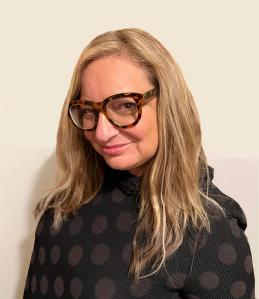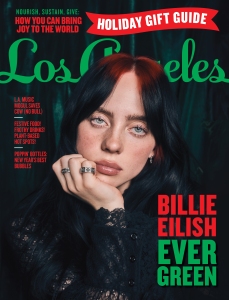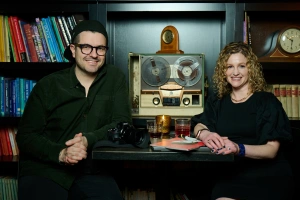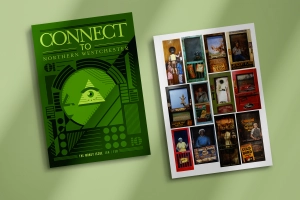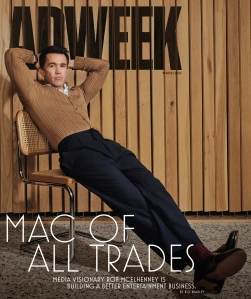Kat Craddock is to SAVEUR magazine what Victor Kiam was to Remington Shavers in the late 1970s. The famous salesman who said, “ I liked the razor so much I bought the company.” And so did Kat Craddock who liked SAVEUR magazine so much, she bought the company.

A restauranteur who fell in love with the magazine at a very young age and was sad to see it halt printing in 2020 decided to do the unthinkable, buy the magazine from its current owners and relaunch its print edition without ignoring the digital space that the magazine enjoys among its faithful readers and followers.
In an all-encompassing conversation with Kat, I had the opportunity to ask her about the relaunch of the magazine in print, the role of print in today’s digital world, and how she is going to achieve success. Her answers were down to earth, passionate and unpretentious. She knows what she is facing and what are the challenges in store for her and the magazine, but, together with her team, she is determined to prove the theory of “print is dead” is wrong.
Kat told me that, “Since we stopped printing in 2020, our readers have been telling us that they wanted the magazine to come back. I knew that enough people loved it and enough people would buy it that we could make it work. Maybe not in the old school distribution models, but I knew that there were enough people out there that wanted the publication that we could deliver something that they were excited about and that we were proud of.”
So, please enjoy this Mr. Magazine™ conversation with Kat Craddock, CEO & EIC of SAVEUR magazine. But first for the soundbites…

On SAVEUR’s mission: SAVEUR is such a particular type of publication with original recipe content, original photography, recipe testing, and travel. It’s so core to our identity. Those are all really expensive things.
On the magazine revenue model: . A lot of the advertising revenue that we are generating is built into these larger packages that are a combination of digital content or experiential and print. Our print magazine is $25 now. We’re not doing discounts for subscriptions.
On the myth of digital vs. print: I guess I’m being a little defiant about it. I don’t like hearing from the industry that since people want digital now, they by default aren’t going to want print. I feel like I have this kind of personal mission to prove that theory wrong.
On what print can offer that digital can’t: There are a lot of different types of storytelling through photography, through different story type, through different story lengths, through design that just don’t translate to digital.
On the role of events in her business model: I want events to become more a part of our business model and our marketing model.
On selling out of the relaunch issue: we sold out, which is a great problem to have. It’s nice to be in a position of going back to our printer who was so wonderful to work with and say, okay, next time we’re going to be doubling our print run.
On what keeps her up at night: I’m a year into basically owning a startup. So probably the, the day-to-day business side of things and making sure that my team is happy and feels supported.
And now for the lightly edited conversation with Kat Craddock, CEO and EIC, of SAVEUR.

Samir Husni: Well, congratulations on the relaunch of SAVEUR.
Kat Craddock: Thank you so much, we’re very excited.
Samir Husni: You’re one of the few who not only relaunched the print magazine, but also have a relaunch party and also sold out of the relaunch issue. What’s going on?
Kat Craddock: Well, a lot’s going on, I guess. We bought the magazine out from our former owner last April. So it’s also our anniversary.
It’s a big anniversary this year. It’s our 30th anniversary as a publication. This month is our first anniversary since being an independent publication.
We relaunched the print magazine last month. We spent the last year working towards the relaunch. That was the first order of business that I really wanted to make sure we were able to do.
Since we stopped printing in 2020, our readers have been telling us that they wanted the magazine to come back. I knew that enough people loved it and enough people would buy it that we could make it work. Maybe not in the old school distribution models, but I knew that there were enough people out there that wanted the publication that we could deliver something that they were excited about and that we were proud of.
We’re starting slow. We’re only going to be doing two a year to get off the ground. So right now we’re working towards our fall/winter issue, which will launch in September and kind of pivoting our team, who largely had done only digital before, to the print mindset.
Getting out of the kind of quick turnaround cycle and working on assigning and shooting some seasonal content for next spring and next fall, which is it’s nice to be back on that rhythm again.
Samir Husni: I see you’re holding, to use a cooking phrase, two pots at the same time. You’re editor-in-chief and you’re a CEO. How are you balancing the job of your love for editorial and being a businesswoman at the same time?
Kat Craddock: Some days are better than others. It’s really exciting. I came from the restaurant world, so I’m used to kind of spinning a lot of plates or holding a lot of pots.
I do wish I had some more time for editorial. There are certain things that I had no idea would take as long as they did, like working through our employee handbook or our terms of use for our website, that sort of thing. I spend a lot more time looking at contracts than I ever thought I would.
But it’s exciting and we’re learning very fast. I have an incredible team, in particular, an incredible operations person who’d worked as our managing editor previously when we were owned by Bonnier. We’re learning very quickly together.
Having her insight into how print publishing and print operations worked in the old method has made it a lot easier for us to kind of pick and choose which systems are going to work for us as an independent pub and which ones we want to kind of reinvent.
Samir Husni: Do you think independent publications are the future of print in this digital age?
Kat Craddock: I can’t really speak for everybody else. SAVEUR is such a particular type of publication with original recipe content, original photography, recipe testing, and travel. It’s so core to our identity. Those are all really expensive things. I think that if we were trying to do a more kind of mass high volume sort of publication rather than something so niche, a lot of what we’re doing wouldn’t necessarily work. But since we know that we have a pretty loyal, devoted niche audience, we can kind of rejigger how our spending works and what we’re spending time on and what we’re not.
Samir Husni: The print editions are not cheap. Are you going more toward consumer revenue model rather than advertising revenue model?

Kat Craddock: All the revenue is important. I’m really trying to get out of putting all of our eggs in one basket. Advertising revenue is still part of the equation. Obviously, print advertising is not this king’s ransom that it used to be. A lot of the advertising revenue that we are generating is built into these larger packages that are a combination of digital content or experiential and print.
Our print magazine is $25 now. We’re not doing discounts for subscriptions. We’re doing a little bit of wholesale direct to retailers. And in those cases, we’re not doing returns. We want to sell out of all these magazines. We don’t want to be throwing a bunch of copies away. The consumer purchase is really at the forefront of what is funding the print product.
Samir Husni: I’ve seen quite a few interviews with you. You’re so passionate about print. Why?
Kat Craddock: I don’t like being told that nobody wants it (print) because I don’t think that’s true. I think that I went into food because I read SAVEUR. I hear that from so many people in the food and beverage industry. After we stopped printing, every single day, somebody told us that they wanted it to come back. And on some level, I guess I’m being a little defiant about it. I don’t like hearing from the industry that since people want digital now, they by default aren’t going to want print.
I feel I have this kind of personal mission to prove that theory wrong.
Samir Husni: What do you think print can offer that digital cannot?
Kat Craddock: That’s a really good question. There are a lot of different types of storytelling through photography, through different story type, through different story lengths, through design that just don’t translate to digital.
And obviously, there’s a lot that print can’t do that digital does really well. And I think that they both complement each other really nicely. We’re not looking to get rid of our website or anything like that.
But if we’re going to be investing in beautiful photography, long form storytelling, and more playful, short form storytelling that leans a lot more heavily on design, why not present that on the most beautiful paper that you can get and give people the opportunity to lean back and look at that content without ads and flash and video and all of this kind of distraction popping up in your face. And I think that people find that really relaxing. It’s a lot more of a pleasure and a luxury to consume media that way.
That’s why we’re not printing 12 of these a year. This is meant to be kind of a slow, leisurely experience to read a print magazine that we’re putting out. But I think that, you know, that different experience is something that print does really well that you just don’t get from consuming media on your phone.
Samir Husni: You’ve opted to bring back the magazine the same dimensions as 2020 and before because you said you have the whole collection on your bookshelf and you don’t want to.
Kat Craddock: It’s right up there. (Pointing to the magazines on her bookshelf). The same cut size, yes. It is significantly longer. It’s 160 pages.
If we’re going to be on stands, or available for six months, we want people to be able to take some time with those stories. We did consider going to a larger cut size. I think that some of the relaunched print magazines are going really big and it is delicious and wonderful to open up like Bitter Southerner or Field and Stream might be going bigger also.
That said, when I unpacked my bookshelves or when I packed my new bookshelves and I got all of the archives up in one beautiful line and I realized how perfectly they all lined up. There are a lot of collectors out there. A lot of people that kept all of their SAVEURs. It’s not just me, the crazy SAVEUR lady that has every issue.
It seemed like it would be a shame for the new issues not feel like they were in the same family. The width had kind of gone up and down over the years a little bit, but the height is exactly the same.
Samir Husni: It has been years since I’ve heard of a magazine launch or relaunch party. It’s
like even if people are relaunching the magazine, they are just doing it like hush hush. It’s like they are ashamed of relaunching it, but you went all out. Based on what I’ve seen on your website you had a great relaunch party.
Kat Craddock: Well, a big part of the reason is that back in 2020 we still had a brick and mortar space in New York City. The whole team was based here. That’s not the case anymore. About half of our team is in New York, but we’ve got editors in Spain and Nashville and Boston and Florida, and everyone worked so hard on this together. I thought it was really important that we had an opportunity to come together to celebrate. We also just really like throwing a party.
Like I said, I came from the restaurant world when we did have our Test Kitchen space. We loved doing events there. I want events to become more a part of our business model and our marketing model.
So it was important to me that we kind of kicked off this important moment for us in person. It was also a great opportunity for a lot of people who worked on SAVEUR over the years to come together. So there were people who have been writing for, contributing to SAVEUR in some way, shape, or form all the way back to the 90s were in attendance.
And to see that level of support from people that worked on a brand that I loved all those years ago was really wonderful. It was nice to see everybody coming together and talking together, too, because these aren’t necessarily people that knew each other at all. But kind of being able to celebrate over something that everyone sort of shares this love for was really nice.
Samir Husni: Tell me a little bit about your audience. People are saying print is more of a nostalgic thing, who is reading SAVEUR?
Kat Craddock: I think about this a lot. I started reading SAVEUR when I was pretty young. My mom got it when I was 10 or so, and I started reading it a couple of years later.
I would love to find young people that are interested in cooking. It’s important to me that we’re developing relationships with the culinary schools in New York City and beyond for that reason. Yes, we have a lot of readers who have been reading us since the 90s.
They’re very valuable and very important to us, and we want to make sure that we’re giving them what they love about SAVEUR, but it is also important that we’re reaching out to that next generation. I think that it gets harder and harder to find print magazines and buy print magazines, but that makes them a little rarer and a little bit more special. We do see young people buying up vinyl records left and right, and I think that nostalgia is valuable to everybody.
It’s not just people that necessarily remember buying print magazines back in the day. I have spoken to a number of journalism students who are excited about print and see the value in it. I don’t think it’s going to get back to the volume again that it once was doing, but people are really appreciating the luxury of buying a print magazine.
Samir Husni: Can you tell me what has been the most pleasant surprise since you acquired the magazine and since you relaunched it?
Kat Craddock: When we announced that we were coming back into print and opened up our presale, I had no idea if people were going to be comfortable with the price point. So I wouldn’t say that’s like the biggest surprise, but I was like the biggest relief that people seem to be okay with it.
I know that some folks balked a bit at the price, but by and large, I think that the readers that really saw the value, they came out. As you mentioned, we sold out, which is a great problem to have. It’s nice to be in a position of going back to our printer who was so wonderful to work with and say, okay, next time we’re going to be doubling our print run.
Hopefully that is a trajectory that we get to stay on moving forward.
Samir Husni: And what was the most challenging moment?
Kat Craddock: Half of our team hadn’t touched print at all. So I wouldn’t say it was a huge challenge, but it was definitely a learning curve for everybody to shift over to. Deadlines in print are a very different thing than deadlines in digital publishing and getting people to kind of shift gears a little bit while still working on digital publishing, editing and writing new content for digital. I know that was hard for everybody. It was even hard for me and I had worked on print before, but just coming out of four years of not thinking that way is definitely a shift.
Samir Husni: Is there any question I need to ask you that I failed to ask you?
Kat Craddock: I would love to talk about our distribution model. I don’t want to be working in a distribution model where a bunch of magazines are going in the trash. We spent a lot on these magazines. They’re very precious to us. And we designed them so that they last for another 30 years on the shelf. They’re not intended to go in the garbage. There is one distributor that that we found that is willing to work with us on a no returns basis.
They’re on the West Coast. They’re Small Changes. They’re lovely.
I don’t know as many bookstores in like the Northwest area. So they were able to kind of help us coordinate with them. Other than that, all of our retail partners are stores that we know and love that we reached out to directly, and they’re buying directly from us.
Bookstores, wine shops, cheese shops, kitchenware stores. These are just shops that we know where the SAVEUR reader is or is likely to be or find us. It’s a lot more plates to spin.
Our brand partnerships person got that program off the ground. And one of our other employees is taking it over now so we can grow our list. You’re not going to find us in, big box bookstores or national supermarket chains at this point.
Samir Husni: My typical last two questions are, if I come uninvited one evening to your house, what do I catch doing? Are you cooking, reading a book, watching TV?
Kat Craddock: I am not cooking as much as I used to. And I really miss that. And I kind of have to force myself to do that because it’s a big part of who I am and why I do this.
But right now the business has definitely taken over my brain space in life. Most nights I’m after the Zoom influx ends, I eat quickly and then I’m back in front of my laptop, usually streaming some television while I answer emails until I crash.
Samir Husni: And what keeps you up at night these days?
Kat Craddock: I’m a year into basically owning a startup. So probably the, the day-to-day business side of things and making sure that my team is happy and feels supported.
Samir Husni: Thank you.





